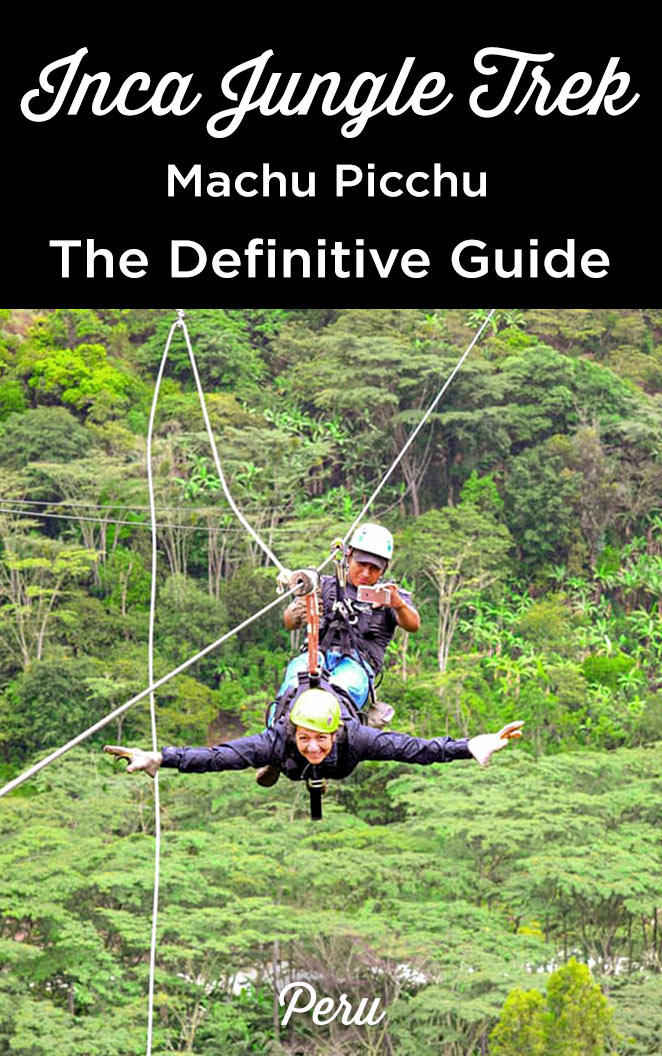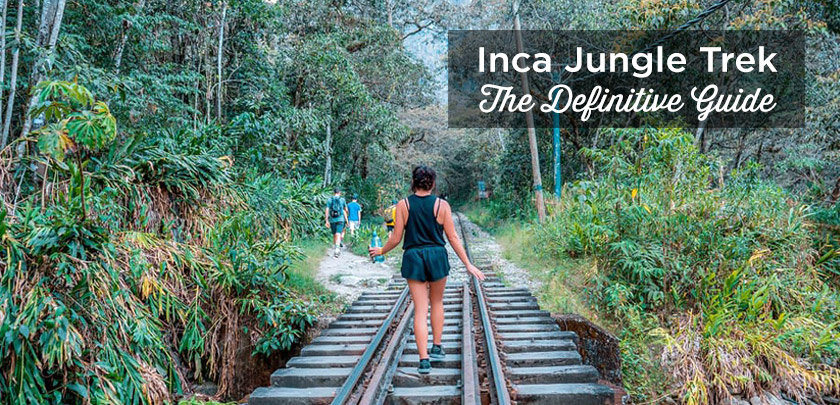Inca Jungle Trail (Machu Picchu): What to Expect + My Experience
Planning to visit Machu Picchu and thinking of adding some adventure to the trip?
Great idea!
Unlike the Classic Inca Trail, the Inca Jungle Trek is a mix of trekking, mountain biking, rafting, and zip-lining, making it one of the most dynamic and affordable ways to reach Machu Picchu.
This 4-day trek will take you from the high Andes to the jungle, passing through Inca ruins and breathtaking landscapes before finally arriving at Machu Picchu.
In this guide, I will tell you everything you need to know to prepare for the trek. You’ll find the detailed itinerary, essential tips, and practical advice to help you make the most of this incredible journey.
So, is the Inca Jungle Trek the right worth it? Let’s find out!
Sommaire
- Inca Jungle Trail (Machu Picchu): What to Expect + My Experience
- 1. Inca Jungle Trail 4-Day Itinerary
- 2. What’s Included in the Inca Jungle Trek?
- 3. How to Book the Inca Jungle Trek?
- 4. What is the best time of year to do the Inca Jungle Trek?
- 5. How can I avoid altitude sickness on the Inca Jungle Trek?
- 6. Is the Inca Jungle Trek open year-round?
- 7. Can I rent equipment for the Inca Jungle Trek?
- 8. How hard is the trek? Can beginners do it?
- 9. Can I do the trek alone, or is a guide required?
- 10. Is the Inca Jungle Trek safe?
- 11. How does this trek compare to the Classic Inca Trail?
- 12. Can I do the Inca Jungle Trek during the rainy season?
- 13. Is travel insurance recommended for the Inca Jungle Trek?
- 14. What to Bring for the Inca Jungle Trek
- Book Your Flight at the Best Price
- Rent a Car in Peru
- Traveling to Peru? These articles will help you!
1. Inca Jungle Trail 4-Day Itinerary
Day 1: Cusco – Abra Málaga – Santa María (Biking & Rafting)
Pick-up was at 6:00 AM, but honestly, I was so excited that it didn’t even feel that early—I was already awake before my alarm, ready to go. I remember feeling both excited and a little sleepy as we set off, knowing this was just the beginning of an unforgettable trip.
The drive to Málaga Pass (4,300m- 14107 ft) takes about four hours, with a stop in Ollantaytambo. It’s a good chance to grab some snacks, stretch your legs, and take in the views before climbing even higher into the mountains.
Once we reached Málaga Pass, the highest point of the trek, the real fun began. The air was crisp and cold, and I could see the peaks towering above us, covered in mist.
This was where we swapped the van for mountain bikes and got ready for the downhill ride into the jungle. If you’ve never biked in the mountains before, don’t worry—you get a full safety briefing, and the bikes come with proper gear (helmet, gloves, knee and elbow pads).
The first few minutes felt freezing, but once I started pedaling, I forgot all about the cold.
The descent is about 65 km (40 miles) and almost entirely downhill, which means you can just enjoy the ride. As we dropped in altitude, I noticed the landscape changing fast—snowy peaks gave way to lush greenery, waterfalls, and coffee plantations.
In certain areas, you’ll share the road with cars, but overall, it’s a smooth ride. If at any point you feel tired or uncomfortable, a support vehicle follows the group, and you can hop in whenever you need to!
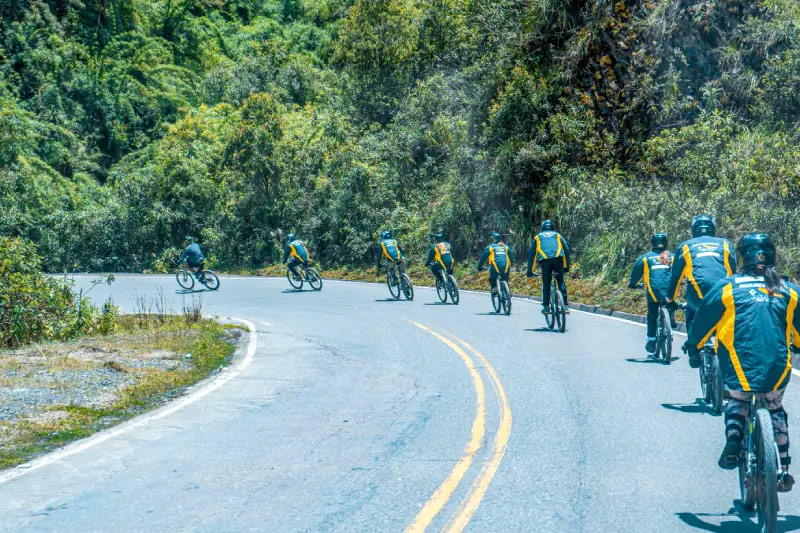
By early afternoon, we arrived in Santa María (1,430m-4690 ft), where a lunch was waiting. After all that biking, I was starving!
The food was simple but delicious—grilled chicken, rice, quinoa, and fresh vegetables. If you’re vegetarian, just let your guide know in advance, and they’ll have options for you.
After lunch, we had the choice to relax in town or try white-water rafting on the Vilcanota River.
I went for the rafting, and I’m so glad I did! The water was fast enough to be exciting but not too intense, and after the first few paddles, I was completely in the moment, just riding the rapids and having fun.
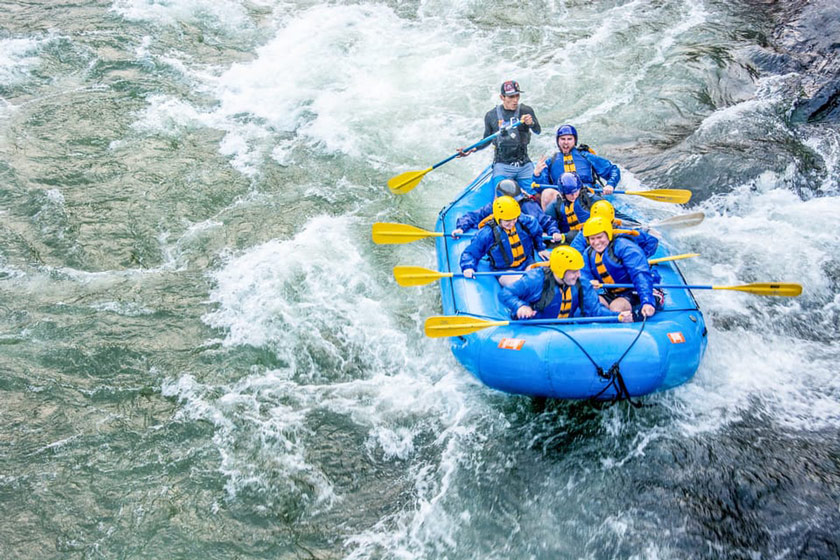
By evening, we checked into a guesthouse in Santa María. The rooms were basic but clean, with private bathrooms and sometimes hot water.
After biking and rafting, I was just happy to have a place to rest. Dinner was in a small local restaurant, and after eating, I was more than ready to sleep—tomorrow would be a full day of hiking.
Day 2: Santa María – Santa Teresa (Hiking & Hot Springs)
The day started early with breakfast, and I knew this would be the first real hiking section of the trek. After a day of biking, it felt good to finally hit the trail on foot.
The first part was a steady uphill climb, following an old Inca path that once connected Machu Picchu with Vilcabamba.
The incline wasn’t too intense, but after the first stretch, I could feel my legs warming up.
Luckily, there were plenty of stops along the way, including a small family-run spot where we rested for a bit, refilled our water, and tried local fruits like bananas and passion fruit. Fresh and sweet, exactly what I needed to keep going.
As we climbed higher, the landscape changed. This was one of the few parts of the trek where we actually on the original Inca road system, an extensive network of trails that once connected the entire empire!
The guide explained how these roads were built centuries ago, and standing on them, I could almost imagine the Incas using the same route.
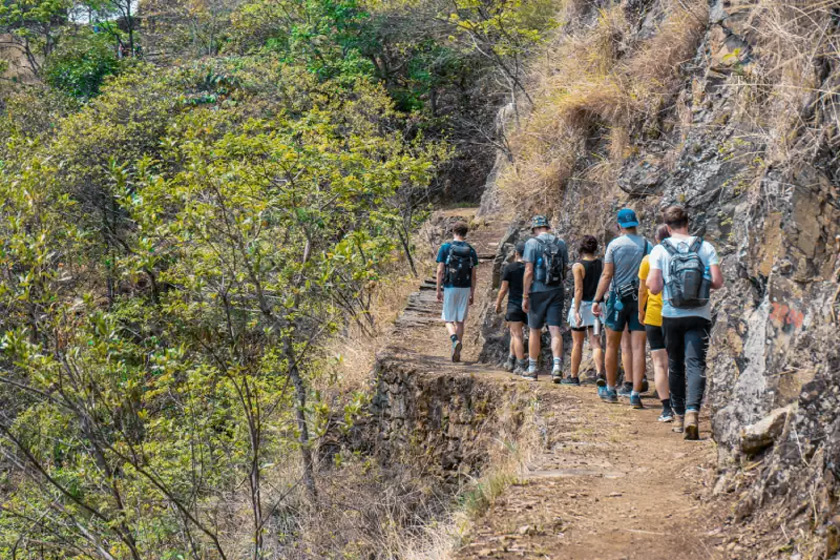
The best part? The views over the Urubamba Valley were absolutely worth the effort. Looking down, I could see deep green mountains stretching endlessly into the distance.
After taking in the scenery, we started the descent toward a small village where we stopped for lunch.
The second half of the day felt much easier—following a path through coffee, coca, and avocado plantations, passing rivers and scattered farmhouses along the way. The weather had changed completely; it was noticeably warmer, and walking through the jungle-like terrain felt completely different from the cool mountain air of the morning.
By mid-afternoon, we arrived in Santa Teresa, a small town best known for its hot springs.
After a full day of hiking, nothing sounded better than soaking in warm water surrounded by mountains.
If you’re planning to visit the hot springs of Cocalmayo in Santa Teresa, don’t forget a swimsuit and a towel.
That night, we stayed in a hostel in Santa Teresa. The rooms were simple but comfortable, exactly what I needed after a long day on the trail.
After dinner at a local restaurant, I didn’t stay up long—tomorrow, we’d be heading to Aguas Calientes, one step closer to Machu Picchu.
Day 3: Santa Teresa – Aguas Calientes (Zip-lining & Hiking)
This morning, after breakfast, there’s the option to try zip-lining before starting the hike.
I decided to go for it, and honestly, I was so glad I did. The moment I took off, the rush was incredible. Flying over the valley with the river far below was something I’ll never forget.
The guide was great. He made everything feel safe and easy, and it ended up being one of the highlights of the trek.
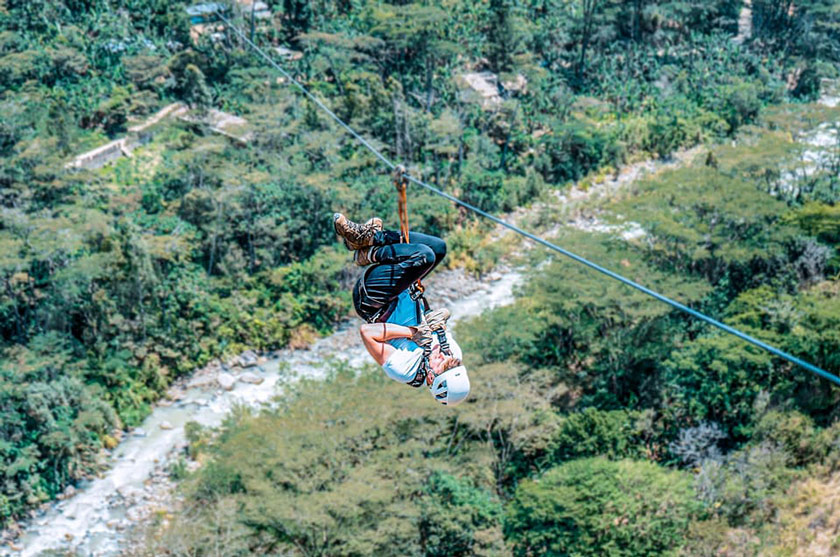
Once everyone was back together, we started walking toward Hidroeléctrica, where we stopped for lunch. Compared to the previous day, this section felt much easier—mostly flat, with views of the jungle and river.
The best part? We finally got our first view of Machu Picchu, way up on the mountain ahead!
After lunch, we continued along the railway tracks leading to Aguas Calientes.
This part of the hike was different—no big climbs, no intense descents, just a peaceful walk through the valley.
The sound of the river, the occasional passing train, and the thick green jungle made it one of the most enjoyable sections of the trek. There were even small stands along the way selling fresh juices and snacks, which was a nice excuse to take short breaks.
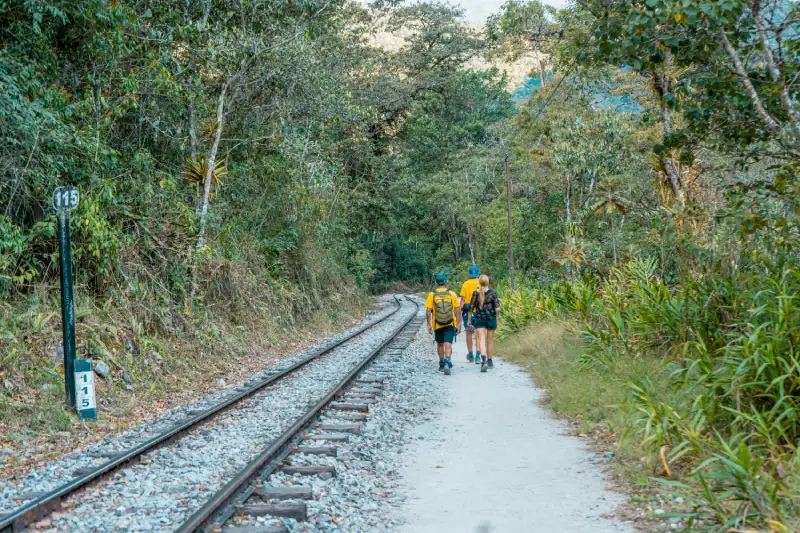
By late afternoon, we arrived in Aguas Calientes, and I was so glad to finally have a real bed and a hot shower. After days of trekking, it felt amazing!
Dinner was in a local restaurant, and after eating, most of us went straight to bed. Tomorrow was Machu Picchu day, and waking up early was non-negotiable.
Day 4: Machu Picchu – Cusco
The final day started before sunrise, and even though waking up wasn’t exactly easy after three days of trekking, knowing that Machu Picchu was just ahead made it impossible to stay in bed.
To reach the entrance, you can either hike up the stairs (about an hour) or take the bus (extra cost, around 30 minutes).
To be honest, the trail up isn’t really worth the extra effort—it’s dusty, buses pass by constantly, and the scenery isn’t great. After all the incredible landscapes I had already walked through, I decided to just take the bus and save my energy to fully enjoy Machu Picchu itself.
Inside, the guide led us through the site, explaining the history, the architecture, and how the Incas built this incredible city in such a remote place. Walking through the terraces, temples, and narrow pathways, it was impossible not to be amazed by what they accomplished.
Keep in mind that these tickets are not included in the Inca Jungle Trek, so you need to book them separately.
Book your preferred ticket here:
To make the most of your visit, read My Full Machu Picchu Guide with everything you need to know!
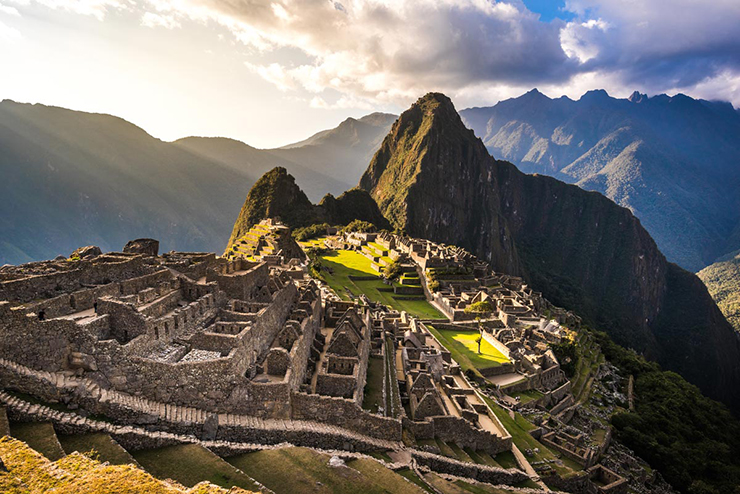
After exploring the ruins, it was time to head back down to Aguas Calientes, grab a final meal, and start the journey back.
Most of the group returned by train, while others took the cheaper car option via Hidroeléctrica.
Instead of going straight to Cusco, I decided to stay in Ollantaytambo for a bit, take a break, and enjoy the town before heading back later.
If you haven’t had the chance to explore the Sacred Valley yet, I highly recommend doing it now—it’s an essential part of any trip to Peru!
2. What’s Included in the Inca Jungle Trek?
Most agencies offer similar packages, but the quality of services can vary a lot—especially when it comes to accommodation, food, and the condition of the bikes.
Here’s what you can usually expect:
What’s Included
- Transport: Pick-up from your hotel in Cusco, private transport to Abra Málaga, and return transportation (usually by train, but always confirm with your tour operator).
- Accommodation: Three nights in basic guesthouses or hostels (Santa María, Santa Teresa, Aguas Calientes). Simple but comfortable, usually with private bathrooms.
- Meals: Three breakfasts, three lunches, and three dinners. The food is basic but filling, and vegetarian options are available if you ask in advance.
- Biking Gear: A mountain bike in decent condition, plus a helmet, gloves, and knee/elbow pads for the downhill ride on Day 1.
- Guide: A bilingual (Spanish/English) guide who leads the trek, shares local history, and ensures everything runs smoothly.
- Machu Picchu Entrance Ticket: The standard entry ticket is included in the trek price.
What’s NOT Included
- Last lunch in Aguas Calientes: After visiting Machu Picchu, you’ll have free time before heading back, but the final meal isn’t covered.
- Huayna Picchu or Machu Picchu Mountain hikes – Must be booked separately, as they’re not included in the trek.
- Drinks & snacks: Water, soft drinks, and snacks along the way are not included, so bring extra cash.
- Tips for guides and staff: Optional, but appreciated if you had a great experience.
- Personal insurance
Some cut corners on safety and equipment, so if the price seems too cheap, there’s usually a reason.
There’s a common saying in Peru: “Lo barato sale caro”, which translates to “Cheap ends up being expensive” It’s worth paying a little more for a serious company with good equipment, reliable guides, and a well-organized trek.
Book your Inca Jungle Trek with a reliable agency here:
3. How to Book the Inca Jungle Trek?
How far in advance should you book?
Unlike the Inca Trail, which you need to book months in advance, or the Salkantay Trek, which is its most popular alternative, the Inca Jungle Trek is much more flexible.
In high season (May to September), I’d still recommend booking at least a few weeks ahead, especially if you want to add Huayna Picchu or Machu Picchu Mountain.
In low season, you can often find spots just a few days before, but I personally prefer booking in advance to avoid last-minute stress.
How to book a Reliable Tour Agency?
Not all agencies in Peru work at the same level, so it’s worth taking a little time to compare before booking. Here’s what I always look for:
- A clear list of what’s included – If an agency doesn’t clearly explain what’s covered (Machu Picchu ticket, transport, meals, activities), I avoid it. A lack of transparency usually means unexpected extra costs along the way.
- Recent positive reviews on platforms like GetYourGuide – Reviews are the best way to see if an agency actually delivers what they promise. If I see multiple bad experiences, I move on.
- Small group sizes – The smaller the group, the better the experience. It usually means more attention from the guide, better logistics, and a smoother trek.
We all want experienced guides and good biking equipment, but let’s be honest—it’s hard to check that in advance.
That’s why I focus on how transparent an agency is, what past travelers say, and whether they keep group sizes reasonable. Those things are usually a good sign that you’re booking with a reliable company.
4. What is the best time of year to do the Inca Jungle Trek?
The best time to hike the Inca Jungle Trek is during the dry season, from April to October.
The weather is more stable, with warm days and cooler nights, making it ideal for biking, hiking, and zip-lining.
The wet season (November to March) brings more rain, making some sections muddy and the biking route more challenging.
If you have the flexibility to choose, I’d recommend doing it in the dry season for a more comfortable experience.
5. How can I avoid altitude sickness on the Inca Jungle Trek?
The highest point on the trek is Abra Málaga (4,300m – 15100 ft), which you’ll reach on Day 1 before biking down to lower elevations.
Most of the trek is in the jungle, where altitude is less of an issue.
Altitude sickness affects everyone differently—some people feel it a lot, while others barely notice it.
I always feel it when I arrive in Cusco, so I take it easy for a couple of days before starting any trek.
Personally, I always feel the altitude when I arrive in Cusco, so I make sure to take it easy on the first day—resting, drinking plenty of water, and even taking a nap.
I have friends who don’t feel anything at all, and honestly, I envy them!
It’s best to spend at least two days at altitude before starting the trek to give your body time to adjust. You can take your time to visit Cusco and explore the Sacred Valley—there’s plenty to see!
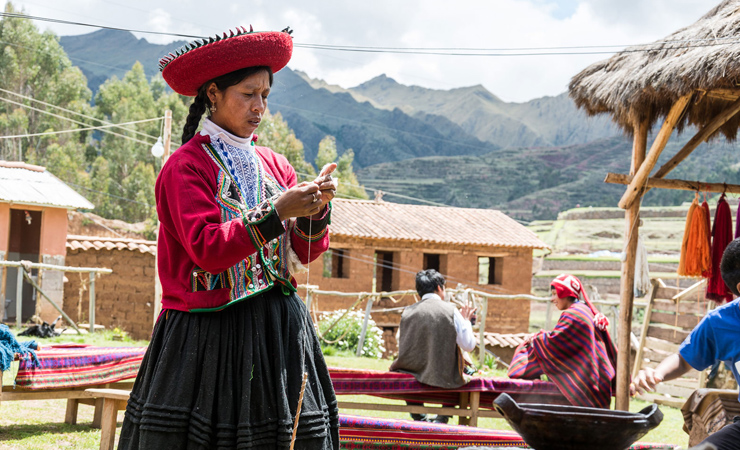
6. Is the Inca Jungle Trek open year-round?
Yes, the Inca Jungle Trek runs all year, but the rainy season (November to March) can make some parts more difficult, especially the biking and hiking sections.
That being said, only the Inca Trail officially closes in February for maintenance and because the path gets too muddy.
The Inca Jungle Trek remains open, but keep in mind that the conditions in February are far from ideal.
7. Can I rent equipment for the Inca Jungle Trek?
Most tour operators provide bikes, helmets, and safety gear for the biking section.
Some agencies also offer walking sticks, rain ponchos, and sleeping bags for rent. It’s always best to ask your tour operator in advance what is included and what can be rented, so you don’t bring unnecessary items or get caught unprepared.
8. How hard is the trek? Can beginners do it?
The Inca Jungle Trek is considered moderate in difficulty. It’s not as intense as the Classic Inca Trail or the Salkantay Trek, but it still requires a good level of fitness.
The main challenge comes from the long hiking distances, uneven terrain, and the mix of activities like biking and zip-lining.
If you’re active and comfortable walking for several hours a day, you should be fine. If you rarely exercise, it’s a good idea to do some light training beforehand, like walking or hiking.
9. Can I do the trek alone, or is a guide required?
The Inca Jungle Trek must be done with a tour operator, unlike the Salkantay Trek, which some people do independently. Since this trek includes biking, rafting, and zip-lining, it requires certified guides for safety.
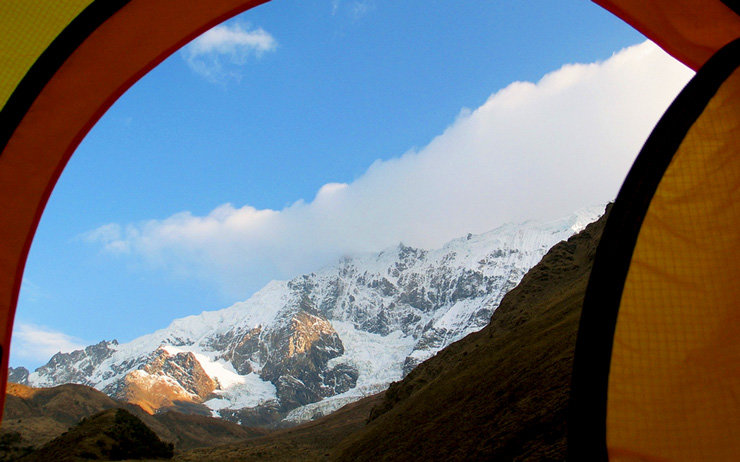
10. Is the Inca Jungle Trek safe?
Yes, as long as you go with a reputable agency that provides proper equipment and experienced guides.
The main risks come from biking downhill and adventure activities like rafting and zip-lining, so it’s important to follow instructions and wear the provided safety gear. I recommend booking with a well-reviewed company to ensure everything is well-organized and safe.
11. How does this trek compare to the Classic Inca Trail?
The Inca Jungle Trek is for those who want a mix of adventure and hiking instead of just walking. It tends to attract a younger, more adventurous crowd—people looking for a fun and active way to reach Machu Picchu rather than just focusing on history and archaeology.
The Classic Inca Trail is a completely different experience. It follows an ancient route used by the Incas, passing through several ruins before reaching Machu Picchu through the famous Sun Gate.
And that’s what makes it so special—it’s the only trek where you actually walk straight into Machu Picchu, just like the Incas did!
This is why it requires a special permit, which agencies must secure months in advance. This makes it more expensive, but the higher cost also reflects the exclusivity, historical significance, and stricter environmental protections of the route.
Book the Inca Trail here:
If you’re looking for a less traditional but more adrenaline-filled way to get to Machu Picchu, the Inca Jungle Trek is a great option.
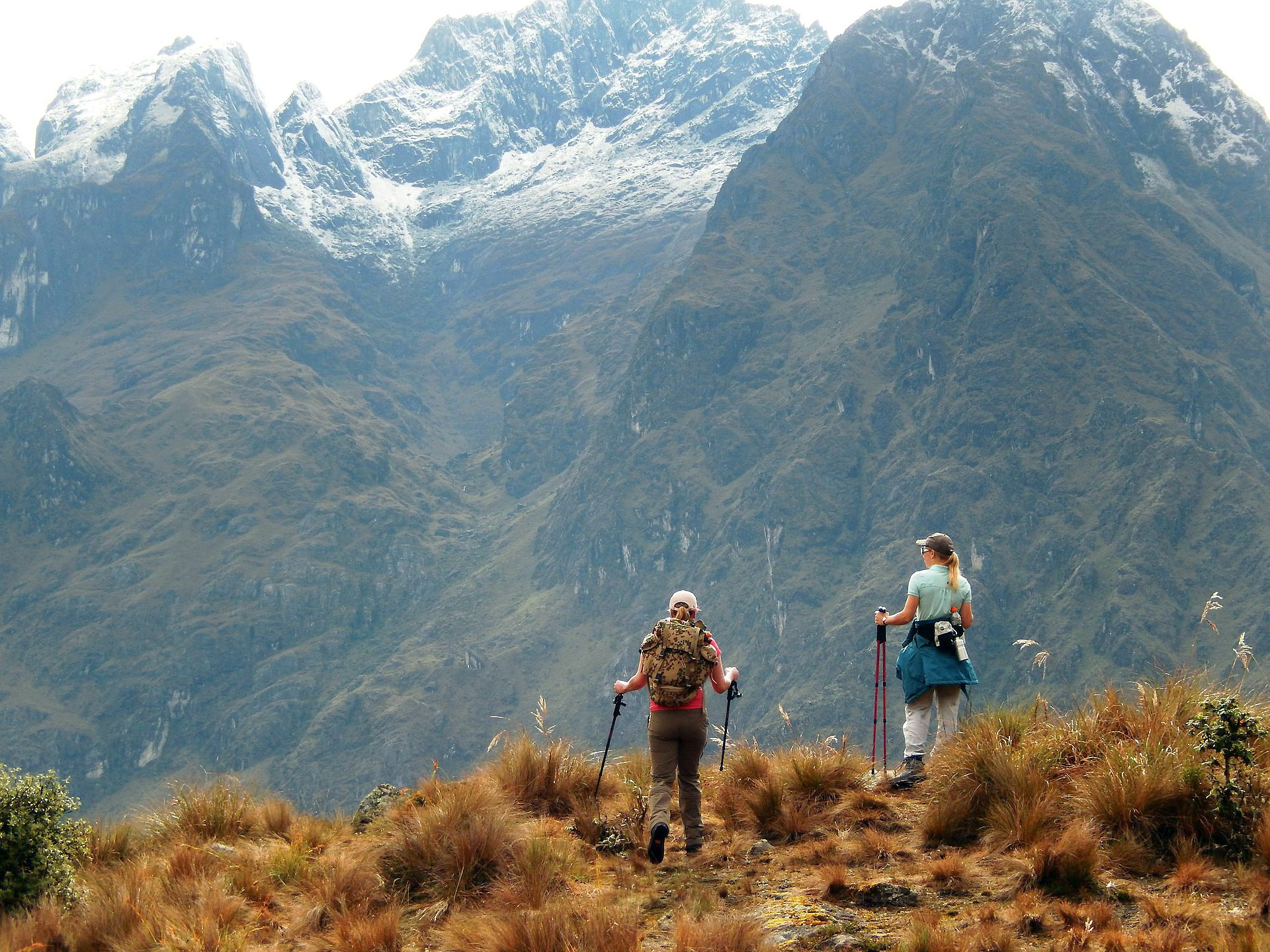
12. Can I do the Inca Jungle Trek during the rainy season?
Yes, the trek runs all year, but expect a lot more rain between November and March.
The biking section can be trickier with wet roads, and the hiking paths can get muddy, so you’ll need to be extra careful, especially on steep or uneven terrain
That being said, only the Classic Inca Trail closes in February, so the Inca Jungle Trek is still an option during that time. If you don’t mind getting wet and want fewer crowds, it can still be a great experience.
13. Is travel insurance recommended for the Inca Jungle Trek?
I always recommend having travel insurance—you never know when you’ll need it. But for a trek like this, with adventure activities involved, it’s even more essential!
Having one will give you peace of mind—hopefully, you won’t need it, but if anything happens, you’ll be glad you have it. 😉
14. What to Bring for the Inca Jungle Trek
You don’t need to bring too much, but there are a few things that will definitely make your trek more comfortable. Here’s what I recommend:
Essentials
- Passport – You’ll need it to enter Machu Picchu, so don’t forget it! I always keep mine in a ziplock bag to protect it from humidity.
- Small backpack (25-30L) – Just enough to carry your daily essentials.
- Cash in soles – Cards are almost never accepted, and although there are ATMs located close to and on the Plaza de Armas in Santa Teresa, I wouldn’t rely on them—sometimes there’s no cash, or they just don’t work.
- Personal insurance – always make sure to have travel insurance—it’s just one of those things you don’t want to skip, especially on a trek with adventure activities!
Clothing
- Hiking shoes or trail runners – You don’t need heavy boots, but make sure they have good grip since some sections can be slippery.
- Sandals or flip-flops – Trust me, after a long day of hiking, you’ll want to take off your shoes and let your feet breathe.
- Breathable hiking clothes – The jungle gets hot and humid, so I always go for lightweight, quick-dry t-shirts and pants.
- Warm layers – Mornings and evenings can be chilly, so a fleece or light jacket is useful.
- Waterproof jacket or poncho – It can rain at any time, especially in the wet season, and nothing is worse than walking for hours in wet clothes.
Other Useful Items
- Insect repellent – This is a must. The mosquitoes in the jungle don’t mess around. I learned the hard way!
- Sunscreen & sunglasses – The sun is strong, especially at high altitudes. Even when it’s cloudy, you can get burned.
- Headlamp or flashlight – Early mornings start in the dark, so having your own light is always a good idea. I didn’t bring one, and I really wished I had!
- Enough water – Tap water in Peru isn’t safe to drink, so you’ll need to bring your own. You can’t just refill anywhere, and while bottled water is available along the way, it’s better to have enough with you from the start.
- Snacks – The meals are good, but I always like having some extra energy bars or nuts for the longer hiking sections.
Book Your Flight at the Best Price
Planning a trip to Peru? To get the best deal on your flights, I recommend using this flight comparison tool, in partnership with Skyscanner.
It’s the easiest way to find the lowest prices for both international flights and domestic flights within Peru—ensuring you pay the best rate with no hassle!
Rent a Car in Peru
Renting a car is one of the best ways to explore Peru at your own pace and make the most of your trip!
Personally, I always use Booking.com Cars for a few key reasons:
- Easily compare prices from all major rental agencies in one place—finding the best deal has never been easier!
- Free cancellation on most bookings, so you can reserve with peace of mind.
- Better insurance coverage at a lower price than rental companies—saving you money with no extra effort.
Click the button below to find the best car rental deals in Peru:
Rent a car
Book entrance tickets and guided visits
Take a travel insurance
Book a tour
✈️ Book your flight
Traveling to Peru? These articles will help you!
Discover all my articles about Mexico: All my articles to help you plan your trip to Mexico are listed there.
You’re using Pinterest? Here is the picture to pin!
